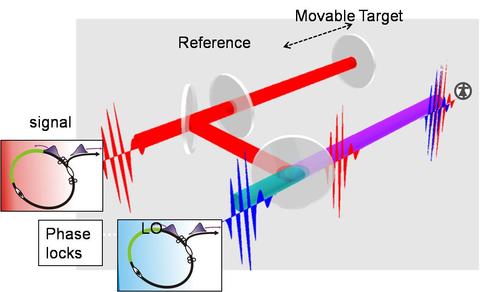Summary
Optical frequency combs convert a laser source containing a single frequency of light into pulses that include thousands of frequencies. This project aims to develop the technology for a growing list of applications. Using a comb working at optical telecommunications wavelengths, project physicists have transmitted signals from next-generation optical atomic clocks across hundreds of kilometers. They have demonstrated how pairs of combs can increase by a factor of one hundred the speed of infrared spectroscopy for chemical analysis, while also enhancing sensitivity. Frequency combs also promise to provide extremely accurate distance measurements and to assess the quality of high-speed telecommunications signals with unprecedented precision.
Description

Schematic diagram of ranging concept. For more information, see Coddington et al, Nature Photonics (June 2009).
NIST has been a world leader in lasers since the technology's development in the early 1960s, a tradition continued when NIST scientist John L. Hall shared the 2005 Nobel Prize in physics for his part in the invention of the optical frequency comb. The output of a comb is a brief broadband pulse containing thousands of different frequencies of light, all with their waves and troughs in sync. The original comb relied on a titanium-sapphire laser, but in the last five years, scientists with the Fiber Laser-Based Frequency Comb Project have built combs using the much cheaper components common to commercial fiber-optic telecommunications equipment, and are exploring its promise in improving timekeeping, speeding chemical analysis, and measuring distances with unprecedented accuracy and enhancing telecommunications clarity.
The ability of frequency combs to gear down the high frequencies of light emitted by individual atoms to frequencies that electronic equipment can handle is crucial to a generation of optical atomic clocks being developed at NIST. The current standard atomic clock uses a cloud of cesium atoms emitting at microwave frequencies, but combs will make it possible for a clock to make use of optical frequency emissions from trapped aluminum, strontium, or mercury atoms. These new clocks promise a ten-fold improvement in accuracy.
Fiber laser-based frequency combs make it possible to translate these new optical clock signals to the infrared frequencies that are perfect for telecommunications, and project scientists have succeeded in sending such signals through 250 km of standard optical fiber. Sharing optical time signals via fiber-optic networks will be essential as optical atomic timekeeping moves from lab to global standard.
Project scientists are also developing a system to improving chemical analysis by infrared spectroscopy. The standard method today involves shining a single color of infrared laser light through a gas, measuring absorption patterns, then moving on to the next frequency. In the system devised at NIST, one comb illuminates a sample with 150,000 colors at once while a second comb monitors absorption on all 150,000 wavelengths. Systems based on this NIST innovation could speed up infrared spectroscopy by a factor of 100 and provide increased diagnostic sensitivity.
The extreme brevity of a frequency comb's pulses — measured in femtoseconds, or millionths of a billionth of a second — makes possible extremely precise measurement of light-travel times and therefore distances. Project scientists are developing a system that promises to measure distances with an accuracy of a few millionths of a meter from kilometers away. An operational system would be ten times more accurate than the best laser radar systems in use today, and could find use in large scale manufacturing or even coordinating the position of satellites.
Project scientists also hope to use fiber laser-based frequency combs to help telecommunication system designers assess the quality of laser signals traveling through their equipment. The work aims to improve upon current optical sampling techniques by using short, broadband frequency-comb pulses to take snapshots of light from the laser modulators that transform electronic data into laser light. The goal is to allow engineers to sample optical signals at different parts of the system, enabling them to pinpoint impairments within optoelectronic hardware or in the optical fiber itself.
Major Accomplishments
- Demonstrated ability to determine absolute distance measurements to nm-precision at long range using fiber-based combs
- Demonstrated, with the NIST Time and Frequency Division, that fiber-based combs can support the most advanced optical clocks
- Demonstrated high-resolution coherent molecular spectroscopy using dual fiber frequency combs
- Demonstrated transfer of high-frequency stability optical signals over 250 km of fiber
- SRM 2514 - Wavelength Calibration Reference for 1560 nm to 1595 nm (Carbon Monoxide C-12/O-16)
- SRM 2515 - Wavelength Calibration Reference for 1595 nm to 1630 nm (Carbon Monoxide C-13/O-16)
- SRM 2517a - High Resolution Wavelength Calibration Reference for 1510–1540 nm Acetylene 12C2H2
- SRM 2519a - High Resolution Wavelength Calibration Reference for 1530 nm -1565 nm Hydrogen Cyanide

